Abstract
Predicting the stress levels of working professionals is one of the most time-consuming and difficult research topics of current day. As a result, estimating working professionals’ stress levels is critical in order to assist them in growing and developing professionally. Numerous machine learning and deep learning algorithms have been developed for this purpose in previous papers. They do, however, have some disadvantages, including increased design complexity, a high rate of misclassification, a high rate of errors, and decreased efficiency. To address these concerns, the purpose of this research is to forecast the stress levels of working professionals using a sophisticated deep learning model called the Deep Recurrent Neural Network (DRNN). The model proposed here comprises dataset preparation, feature extraction, optimal feature selection, and classification using DRNNs. Preprocessing the original dataset removes duplicate attributes and fills in missing values.
1. Introduction
The working conditions of professionals in India are deteriorating at an alarming rate in modern society. As per the Automatic Data Processing (ADP) Research Institute’s most recent reports for 2020, 70% of Indian workers are stressed out at work, which is a major cause for concern. There has been a rise in the number of professionals who are sad or at risk of suicide as a result of increased stress according to surveys conducted by 1 to 1 help, an Employee Assistance Program provider in India. In the year 2017, OSMI, also known as Open Sourcing Mental Illness, was in effect. There were 750 responses to the survey from staff members. The dataset initially consisted of 68 features drawn from both the subjects’ personal and professional lives. Optum, a NASSCOM-affiliated company, found that nearly half of Indian workers were experiencing stress or mental health issues. Seventy significant corporations, each with a maximum and a minimum of 4000 and 500 employees, respectively, were questioned. The findings were frightening, revealing a two-year rise in the percentage of employees at high risk of suicide-related stress between 40% and 80%. They also discovered that the most common sources of stress for workers were relationships with family and finances [1,2,3,4]. These mechanisms [5,6,7,8] are primarily concerned with predicting the moods of working professionals based on their job performance, their mental state before and after work hours, and participation in office activities.
Machine learning is typically one of the most widely used categorization models for tackling specific prediction issues [9,10]. Artificial Intelligence (AI) models include Support Vector Machines (SVMs), Neural Networks (NNs), Relevance Vector Machines (RVMs), Naive Bayes (NB), Decision Trees (DTs), Logistic Regression (LR), and K-Nearest Neighbor (KNN). Deep-learning-based classification [11,12,13,14] models, when compared to these techniques, deliver efficient and accurate performance results for any complicated challenge. Long Short-Term Memory (LSTM), Deep Neural Networks (DNNs), Convolutional Neural Networks (CNNs), and Deep Belief Networks (DBNs) are all included. Deep-learning-based categorization techniques are more suitable for properly predicting the mindset and stress levels of working professionals in the workplace because they offer accurate prediction outcomes, an increased performance rate, efficiency, and decreased time consumption. As a result, the goal of this research is to use an advanced deep learning model to anticipate working professionals’ stress levels based on their comments. The original dataset is preserved here, along with several features of the working professionals’ information and feedback. This makes use of prediction sources that have quickly been processed to accurately predict working professionals’ stress levels. The following are the contributions of this research:
- A deep learning model based on a DRNN is used to accurately identify whether professionals are anxious.
- The given dataset is preprocessed by removing the unnecessary set of attributes and filling in the missing values to obtain a normalized dataset and by also extracting and choosing the most appropriate number of features from the pre-processed dataset to train the data model in order to improve the classifier’s prediction performance.
- Various assessment metrics are validated to assess the effectiveness of the proposed prediction mechanism, including accuracy, precision, recall, sensitivity, specificity, error rate, and F1-score.
2. Background
This section summarizes some of the research on various machine learning and deep learning algorithms used to predict the stress levels of working professionals. It also discusses the advantages and disadvantages of each technique in terms of its operational functions and characteristics. A previous study looked at the performance of employees concerning three key aspects, namely, workload, job security, and shift work, with a sample size of 100 participants [15]. Stressors and workplace performance were compared using a variety of statistical approaches, such as T-tests, chi-squared tests, correlations, and regression analyses. These three characteristics were found to be favorably linked and to have a significant impact on the performance of employees. Workload was determined to have the greatest effect on employees’ performance out of all of the factors [16]. An improved deep learning approach was proposed to forecast human stress based on the finite element analysis. According to [17], Deep Neural Networks (DNNs) are effective at predicting stress components from given data.
Researchers developed a multi-task learning mechanism to predict a person’s mood, health, and stress levels. The automatic prediction process was also improved using the Domain Adaptation (DA) technique. The Gaussian Progression (GP) model was used to further investigate the non-linear relationship. According to this paper, the Deep Neural Network (DNN) technique produces accurate prediction results. However, it is constrained by the issue of increasing algorithm complexity, which reduces the system’s overall performance. Sumathi et al. [18] came up with a good way to deal with stress that can be used to measure how stressed female educators are [19].
We looked at the work of different authors who wrote about stress at work and put them into different groups based on certain factors. The authors put all of the sources and literature into four groups: journals; author profiles; research methods; and industries or types of research. After looking over the conceptual and descriptive research on work stress, they found that they could understand the basics and get a handle on it. The research also found that there were more empirical studies than exploratory or longitudinal studies and that most of the articles were written by academics rather than professionals. The US, the UK, and India were the top three countries that contributed to these research papers and other materials. They also found that, even though India has contributed to this research based on both practical and theoretical knowledge about stress and its effects, the scientific findings have not been used much to solve the real problem. To reduce stress, the right management techniques and tools are not being used; they are still only on paper. Research also shows that stress at work affects a person’s physical and mental health, as well as how well they do their job and how productive they are at the company.
Work stress can also cause diseases, such as coronary heart disease, high blood pressure, depression, anxiety, and nervousness. Ref. [20] wanted to find solutions for the monitoring of real-time stress levels using machine learning approaches. The approaches evaluated in this research included SVMs, LDA, NB, KNN, and Decision Trees (DTs). The training and testing difficulties of all of these strategies were also estimated based on their work stages and computations. These models have three stages: pre-processing, feature extraction, and classification. There were 240 participants in the case research conducted in China, and data were gathered through the use of a questionnaire with 24 questions. An analysis of the university faculty’s work stress was conducted using ANOVA and multifactor line regression.
The stress levels of the university faculty were found to be highly influenced by the faculty member’s professional rank, age, and teaching experience. Administrative issues, institutional limits, and faculty members’ traits all played a factor in the level of stress they experienced on the job. Teachers’ work-related stress has skyrocketed as a result of the evaluation system’s reliance on quantitative performance metrics, according to this research [21]. The researcher recommended a General Regression Neural Network (GRNN) model to evaluate the individual stress component. The goal of this article was to precisely calculate a person’s stress level by evaluating data and categorizing information. The stress level was calculated based on the baseline, task load, and recovery stages. However, this paper’s fundamental flaw was that it encountered significant problems in task handling operations [22]. Using session data, the implementation of machine learning algorithms for advanced resource planning in hospital emergency departments is demonstrated by [23].
Light gradient boosting machines (LGBMs) are a new ML model developed by the authors. They observed that LGBM’s efficiency and prediction time were superior to those of other common machine learning models, such as Decision Trees and GBMs. Ref. [24] used an Artificial Neural Network (ANN) and LR models. The authors’ main goal was to improve classification accuracy by processing the given dataset with efficient prediction models. The probability of distribution was calculated using the strongest association between environmental stress and social interpersonal stress components. Ref. [25] proposed a novel data mining method to determine a person’s stress level based on their activities.
The Multi-Layer Perceptron (MLP) model has been used in this system for this purpose, which aids in determining the cause of depression. Preprocessing, classification, and prediction are the three main processes in this system. To improve the accuracy of prediction analysis, the fuzzy unordered rule method was combined with the multi-objective evolutionary technique. According to the findings of this research, various forms of machine learning and deep learning models can be used to predict the stress and depression levels of working professionals by efficiently processing datasets with certain properties. In addition, when compared to other techniques, deep-learning-based classification algorithms produce more accurate prediction outcomes. However, the current systems are constrained by fundamental issues, such as increased algorithm complexity, increased time spent training the model, and high misclassification rates. As a result, the goal of this research is to create an effective deep learning model for accurately forecasting working professionals’ stress levels with a high accuracy rate [26].
The classification of stress using a deep learning model is proposed. A neural network model is used to merge the WESAD dataset’s continuous and categorical input values. Categorical variables are represented by using the entity embedding technique, where each fixed value is represented as a numeric vector, often with low dimensionality. Only skin conductance is used to evaluate the classifier’s performance. Such a strategy seeks to maximize practicality by minimizing the number of sensors while retaining high levels of precision.
3. Methodology
The suggested stress prediction system for working professionals is described in detail in this section, which includes flow diagrams and computer examples. By utilizing an advanced deep learning classification technique, this research aims to increase the accuracy and efficiency of a stress prediction system. This study considers a public dataset, namely, the Stress Dataset, which is publicly available in Kaggle [27]. The dataset comprises the stress data of different individuals in the area of occupation. Figure 1 depicts the overall flow of the proposed system, which includes various stages, such as data preprocessing, feature extraction, feature selection, and classification. After the dataset is loaded, it is normalized by filling in the missing and incorrect values. Throughout this process, a collection of both dependent and independent variables is defined to predict the missing values. A set of features is then selected from the normalized dataset, with the most relevant features being chosen to improve prediction accuracy. Last but not least, a deep learning model that is built on a DRNN is utilized to correctly predict whether working professional are anxious.
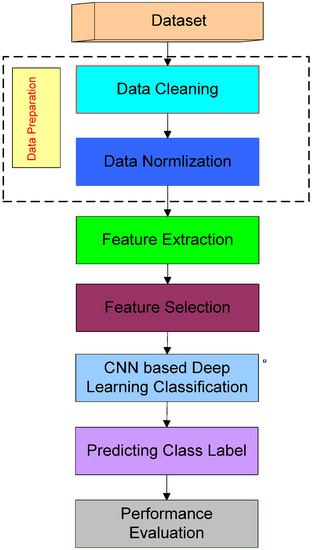
Figure 1.
The flow of the planned system.
We used the stress professional’s dataset. In the initial stage, the cleaning of the data is performed; the data are normalized; the required features are extracted; and later, the desired features are selected for further processing. To classify images, the CNN-based deep learning model is applied to the selected features, and new values are predicted. Finally, a performance evaluation is conducted on the new model.
3.1. Data Pre-Processing
The working professionals dataset serves as the processing input, and it contains some useless attribute information, as well as missing values. The missing values are filled by zero filling in the missing values. This type of data could reduce classification accuracy and lengthen the training time. As a result, the dataset’s properties and fields must be normalized before it can be used. This step includes data cleaning and filtering to remove any unnecessary data from the original dataset. The missing values are filled, and the overall fields are filtered to obtain the normalized dataset. The Perceived Stress Scale (PSS) factor is created to investigate the types of scenarios that can cause working professionals to become stressed, as well as their ability to cope with those situations. This can be determined based on criteria such as their mental states and stress levels when confronted with common situations. After this, feature extraction and classification can be performed on this dataset because the data in the dataset affect the stress prediction system’s overall performance.
3.2. Feature Extraction
Feature extraction is an important stage in any prediction or classification system since it allows for new features to be produced from the original features of the data (Algorithm 1). It is also regarded as a critical step in classification since the traits and performance of working professionals greatly influence learning outcomes. The normalized dataset is used in this system to extract five different types of features: average time, total activities, average idle time, key strokes, and other activities.
| Algorithm 1. Extraction of Feature |
| 1: Input: dataset that has been normalized; |
| 2: Output: A collection of features that have been extracted ; |
| 3: Step 1: for e = 1 to EID//EID—The number of working professionals who have their ID; |
| 4: Calculate how long it will take them to complete their desired tasks; |
| 5: End for; |
| 6: Step 2: With their own ID, estimate the unique activities of working professionals. |
| 7: Step 3: For q = 1 to size |
| 8: For w = 1 to size |
| 9: For p = 1 to size |
| 10: Calculate the average amount of time A T that each working professional needs to complete their tasks; |
| 11: Calculate the total E T of all working professionals’ activities for completing their tasks; |
| 12: Compute the idle time of every working professional; |
| 13: Calculate the average number of keystrokes, ; |
| 14: Calculate each working professional’s other activities, OA T, to complete the tasks; |
| 15: The end for p; |
| 16: The end for w; |
| 17: The end for q; |
| 18: Step 4: Extracted feature set |
3.3. Feature Selection
The process of selecting the most optimal characteristics to correctly predict categorized results is known as feature selection. The most relevant attributes are chosen from the extracted feature sets, resulting in a reduction in feature dimensionality. An increased number of characteristics may harm the classifier’s performance during the training and testing phases. The required attributes are optimally chosen using the alpha-investing strategy to address this problem. The main reason for using this method is that it accurately identifies all possible combinations of all attributes, significantly improving the proposed working professional stress prediction system’s accuracy.
3.4. Classification Based on DRNN
At this point, the best set of features is collected as the processing input, and the predicted label is generated as the processing output. The most popular deep learning technique, known as the Deep Recurrent Neural Network (DRNN), is applied in this work for this aim. The major goal of employing this strategy is to be able to train the model to handle the given problem with more accuracy and less time spent on it. Additionally, it effectively trains the network several times to obtain a high-performance rate. RNN is typically an extension of the widely utilized LSTM (Figure 2 presents the LSTM model) approach for tackling mood prediction problems.
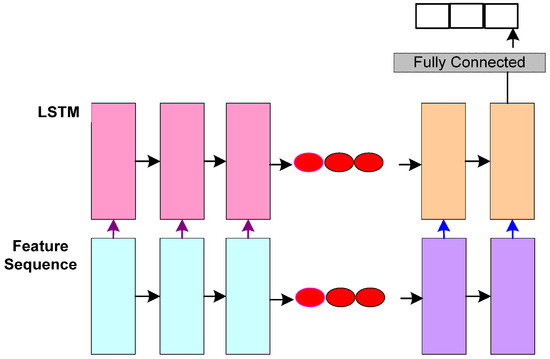
Figure 2.
LSTM model.
As a result, the suggested system employs the DRNN technique to forecast working professionals’ stress levels. This model is made up of many recurrent hidden RNN states stacked on top of each other. The DRNN technique, when compared to the traditional LSTM and RNN techniques, streamlines the computing process while improving accuracy. Furthermore, it effectively collects high-level information to properly predict the categorized label. This technique’s parameters are fine tuned to produce results based on the best feature vectors. Figure 3 presents the DRNN architecture and Figure 4 presents the Structure of DRNN respectively.
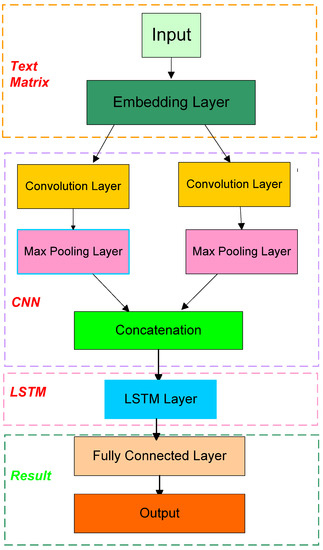
Figure 3.
DRNN model’s architecture.
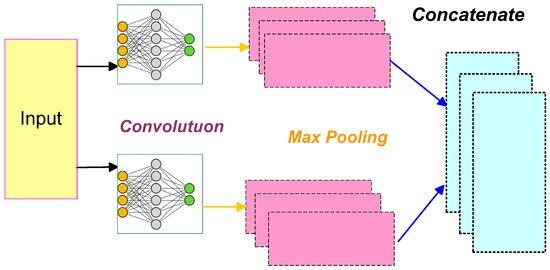
Figure 4.
DRNN structure.
The activation function is computed with the number of filters in this model, which uses a 1D convolutional layer to convolve the given input. The feature map’s dimensionality is then calculated using the following model (Equation (1)):
where FMH2 specifies the height of the feature map, IH1 signifies the input height before convolution, CKH denotes the height of the convolutional kernel, Ps denotes the padding size, S refers to the step size, and CKH denotes the height of the convolutional kernel. The local input characteristics are then extracted using a single convolution kernel using Equations (2)–(4):
where indicates the convolution kernel function with height , and represents the output after convolution. Consequently, the maximum pooling layer is utilized to pool all convolved results concerning the extracted feature set of text, shown in Equations (5) and (6) as follows:
4. Results and Discussion
In the end, the concatenated output is produced as the output, and it provides the classified label indicating whether working professionals experience stress or do not experience stress. The following is a list of the primary benefits that result from conducting this work:
- Simple design;
- Accurate prediction of results;
- Reduced time consumption for training and testing models;
- Better performance rate.
This section explores the outcomes of the existing and proposed techniques in terms of various evaluation metrics, namely, Accuracy, Precision, Recall, Sensitivity, Specificity, F1-Score, and Error Rate.
The figures are calculated as follows:
TP stands for True Positives, TN stands for True Negatives, FP stands for False Positives, and FN stands for False Negatives. The Accuracy, Precision, and Recall measures of the existing and proposed classification techniques are shown in Table 1 and Figure 5. As a result, the RMSE and F1-Score of the existing techniques, namely, ANN, LR, NB, SVM, and DT, and the proposed classification technique are shown in Table 2 and Figure 6. Typically, the performance of a prediction system is determined by these factors, with the number of features/attributes used to train the data model having a significant impact on the accuracy of a working professional’s stress prediction. The proposed DRNN technique outperforms the other techniques in terms of Accuracy, Precision, Recall, F1-Score, and RMSE values, as evidenced by the results. This demonstrates that the proposed DRNN-based working professional stress prediction technique outperforms other techniques in terms of overall performance.

Table 1.
Accuracy, precision, and recall measures of existing and proposed techniques.

Figure 5.
Accuracy, precision, and recall of existing and proposed techniques.

Table 2.
F1-scores and RMSE measures of existing and proposed techniques.
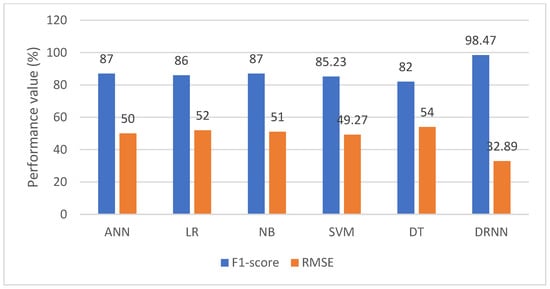
Figure 6.
RMSE and F1-score of both existing and proposed techniques.
Furthermore, the prediction performance of the existing SVM and ANN techniques and the proposed DRNN technique is assessed using a variety of working professionals’ sessions, as shown in Figure 7 and Table 3. Based on these findings, it is determined that the proposed DRNN technique outperforms the existing techniques because, in the proposed system, the working professionals’ stress is predicted before and after work, as well as their participation in all of the institution’s events. Additionally, the working professionals’ feedback is collected and updated with the dataset, in which the most appropriate features for improving classification performance are extracted.
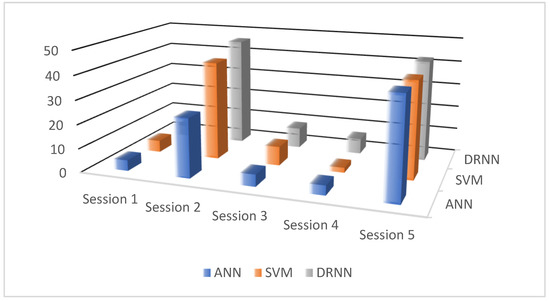
Figure 7.
Comparative analysis between existing and proposed classification techniques for varying sessions.

Table 3.
Prediction performance under various sessions.
The prediction results of the existing and proposed deep learning models for the categories of mood, health, and stress factors are shown in Table 4 and Figure 8. The results show that, by training the model with the optimal set of features, the proposed DRNN-based deep learning model accurately predicts the mood of working professionals. It aids in improving system performance, as well as providing accurate stress prediction in working professionals.

Table 4.
Mood, health, and stress prediction outcomes of existing and proposed classification techniques.
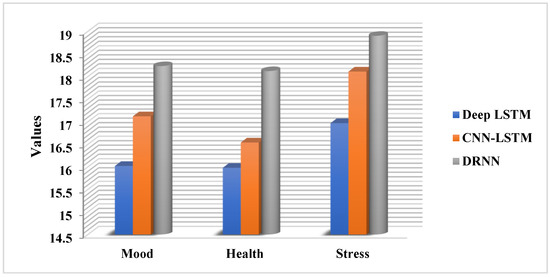
Figure 8.
Prediction results of existing and proposed deep learning models.
5. Conclusions
Using a deep-learning-based classification technique, this paper presents an improved model for predicting the stress level of working professionals. The goal of this article is to improve prediction accuracy by choosing the best features for classification. Preprocessing, feature extraction, selection, and classification are all included in this article. The original dataset, which contains information and feedback from working professionals, is first preprocessed to normalize the contents by removing irrelevant data and filling in missing values. A set of features is then extracted and optimally selected to improve the classification’s overall effectiveness. Following that, the DRNN technique is used to accurately predict whether a working professional is stressed based on the optimal number of features and the working professional’s feedback. The system’s main advantages are its simple design structure, efficient performance, accurate classification, and reduced training model time. The proposed technique’s performance is validated and compared to other state-of-the-art models using various measures in experiments. The proposed DRNN technique outperforms the other techniques in terms of accuracy, sensitivity, specificity, precision, recall, and error rate, as evidenced by the results. This work can be expanded in the future by incorporating other deep learning models for real-time application systems. The proposed model provides better accuracy than the existing models.
Author Contributions
Conceptualization, S.D.S.; Data curation, S.S.; Formal analysis, R.S.; Funding acquisition, B.T.; Investigation, A.G.; Project administration, N.P. All authors have read and agreed to the published version of the manuscript.
Funding
The APC was funded by the Tshwane University of Technology, South Africa.
Institutional Review Board Statement
Not applicable.
Informed Consent Statement
Not applicable.
Data Availability Statement
Data available on request.
Conflicts of Interest
The authors declare no conflict of interest.
References
- ADP Research Institute. The Workforce View. 2020. Available online: https://www.adpri.org/wp-content/uploads/2020/10/06223715/COLL_WFV_Vol2-Print_US_2020_570908_98571_FV.pdf (accessed on 30 July 2022).
- Reddy, U.S.; Thota, A.V.; Dharun, A. Machine learning techniques for stress prediction in working employees. In Proceedings of the 2018 IEEE International Conference on Computational Intelligence and Computing Research (ICCIC), Madurai, India, 13–15 December 2018; pp. 1–4. [Google Scholar] [CrossRef]
- Workplace Stress. Available online: https://www.stress.org/workplace-stress (accessed on 30 July 2022).
- Employee Wellness by Optum, Affiliated with NASSCOM. Available online: https://nasscom.in/employee-wellness/ (accessed on 28 July 2022).
- Flesia, L.; Monaro, M.; Mazza, C.; Fietta, V.; Colicino, E.; Segatto, B.; Roma, P. Predicting perceived stress related to the COVID-19 outbreak through stable psychological traits and machine learning models. J. Clin. Med. 2020, 9, 3350. [Google Scholar] [CrossRef] [PubMed]
- Vijayan, M. Impact of job stress on employees job Performance in aavin, coimbatore. J. Organ. Hum. Behav. 2017, 6, 21. [Google Scholar]
- Romaniszyn-Kania, P.; Pollak, A.; Bugdol, M.D.; Bugdol, M.N.; Kania, D.; Mańka, A.; Danch-Wierzchowska, M.; Mitas, A.W. Affective state during physiotherapy and its analysis using machine learning methods. Sensors 2021, 21, 4853. [Google Scholar] [CrossRef]
- Xiang, F.; Liu, B. A study on work stress of real estate industry knowledge workers on the basis of psychological contract. In Proceedings of the 2012 International Conference on Management Science & Engineering 19th Annual Conference Proceedings, Dallas, TX, USA, 20–22 September 2012; pp. 1272–1280. [Google Scholar]
- Sükei, E.; Norbury, A.; Perez-Rodriguez, M.M.; Olmos, P.M.; Artés, A. Predicting Emotional States Using Behavioral Markers Derived From Passively Sensed Data: Data-Driven Machine Learning Approach. JMIR Mhealth Uhealth 2021, 9, e24465. [Google Scholar] [CrossRef] [PubMed]
- Srividya, M.; Mohanavalli, S.; Bhalaji, N. Behavioral modeling for mental health using machine learning algorithms. J. Med. Syst. 2018, 42, 1–12. [Google Scholar] [CrossRef] [PubMed]
- Jaques, N.; Taylor, S.; Sano, A.; Picard, R. Multimodal autoencoder: A deep learning approach to filling in missing sensor data and enabling better mood prediction. In Proceedings of the 2017 Seventh International Conference on Affective Computing and Intelligent Interaction (ACII), San Antonio, TX, USA, 23–26 October 2017; pp. 202–208. [Google Scholar]
- Rosa, R.L.; Schwartz, G.M.; Ruggiero, W.V.; Rodríguez, D.Z. A knowledge-based recommendation system that includes sentiment analysis and deep learning. IEEE Trans. Ind. Inform. 2018, 15, 2124–2135. [Google Scholar] [CrossRef]
- Ghosal, S.; Blystone, D.; Singh, A.K.; Ganapathysubramanian, B.; Singh, A.; Sarkar, S. An explainable deep machine vision m for plant stress phenotyping. Proc. Natl. Acad. Sci. USA 2018, 115, 4613–4618. [Google Scholar] [CrossRef] [PubMed]
- Aceto, G.; Ciuonzo, D.; Montieri, A.; Pescapé, A. Mobile encrypted traffic classification using deep learning: Experimental evaluation, lessons learned, and challenges. IEEE Trans. Netw. Serv. Manag. 2019, 16, 445–458. [Google Scholar] [CrossRef]
- Jaber, D.; Hajj, H.; Maalouf, F.; El-Hajj, W. Medically-oriented design for explainable AI for stress prediction from physiological measurements. BMC Med. Inform. Decis. Mak. 2022, 22, 38. [Google Scholar] [CrossRef] [PubMed]
- Liang, L.; Liu, M.; Martin, C.; Sun, W. A deep learning approach to estimate stress distribution: A fast and accurate surrogate of finite-element analysis. J. R. Soc. Interface 2018, 15, 20170844. [Google Scholar] [CrossRef] [PubMed] [Green Version]
- Jaques, N.; Taylor, S.; Sano, A.; Picard, R. Predicting tomorrow’s mood, health, and stress level using personalized multitask learning and domain adaptation. J. Mach. Learn. Res. 2017, 66, 17–33. [Google Scholar]
- Sumathi, V.; Velmurugan, R.; Sudarvel, J.; Sathiyabama, P. Intelligent Classification of Women Working in ICT based Education. In Proceedings of the 2021 7th International Conference on Advanced Computing and Communication Systems (ICACCS), Coimbatore, India, 19–20 March 2021; pp. 1711–1715. [Google Scholar]
- Burman, R.; Goswami, T.G. A systematic literature review of work stress. Int. J. Manag. Stud. 2018, 5, 112–132. [Google Scholar] [CrossRef]
- Nath, R.K.; Thapliyal, H.; Caban-Holt, A.; Mohanty, S.P. Machine learning based solutions for real-time stress monitoring. IEEE Consum. Electron. Mag. 2020, 9, 34–41. [Google Scholar] [CrossRef]
- Meng, Q.; Wang, G. A research on sources of university faculty occupational stress: A Chinese case study. Psychol. Res. Behav. Manag. 2018, 11, 597–605. [Google Scholar] [CrossRef]
- Xu, Q.; Nwe, T.L.; Guan, C. Cluster-based analysis for personalized stress evaluation using physiological signals. IEEE J. Biomed. Health Inform. 2014, 19, 275–281. [Google Scholar] [CrossRef]
- Rawat, S.S.; Sultana, R. Advance Resource Planning in Hospital Emergency Departments Using Machine Learning Techniques. Int. J. Hum. Cap. Inf. Technol. Prof. 2021, 12, 74–86. [Google Scholar] [CrossRef]
- Mohd, N.; Yahya, Y. A Data Mining Approach for Prediction of working pregnant women Depression Using Logistic Regression And Artificial Neural Network. In Proceedings of the 12th International Conference on Ubiquitous Information Management and Communication, New York, NY, USA, 5–7 January 2018; pp. 1–5. [Google Scholar]
- Billah, M.A.-M.; Raihan, M.; Alvi, N.; Akter, T.; Bristy, N.J. A Data Mining Approach to Identify the Stress Level Based on Different Activities of Human. In Proceedings of the 2021 International Conference on Information and Communication Technology for Sustainable Development (ICICT4SD), Dhaka, Bangladesh, 27–28 February 2021; pp. 31–34. [Google Scholar]
- Liapis, A.; Faliagka, E.; Antonopoulos, C.P.; Keramidas, G.; Voros, N. Advancing Stress Detection Methodology with Deep Learning Techniques Targeting UX Evaluation in AAL Scenarios: Applying Embeddings for Categorical Variables. Electronics 2021, 10, 1550. [Google Scholar] [CrossRef]
- Stress Datasets. Available online: https://www.kaggle.com/datasets/qiriro/ieee-tac (accessed on 10 July 2022).
Publisher’s Note: MDPI stays neutral with regard to jurisdictional claims in published maps and institutional affiliations. |
© 2022 by the authors. Licensee MDPI, Basel, Switzerland. This article is an open access article distributed under the terms and conditions of the Creative Commons Attribution (CC BY) license (https://creativecommons.org/licenses/by/4.0/).